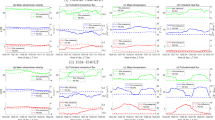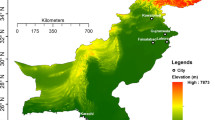Abstract
We propose a new formulation for the wind-speed profile in the urban boundary layer, which can be viewed as a generalisation of the commonly used logarithmic law. The model is based on the assumption that the role played by the classical aerodynamic roughness length and the displacement height in the logarithmic law is taken by a sole variable, the local length scale, which follows a pattern of exponential decrease with height. Starting from wind-speed profiles collected at Villa Pamphili park, Rome, Italy, an empirical fit is used to determine the model parameters. The results show that the local length scale depends also on the friction velocity and that, with appropriate normalization, it reduces to a family of curves that spreads according to the planar area fraction. Another novel aspect is the estimation of the roughness sublayer depth, which can be expressed as a function of the friction velocity and morphometric quantities such as the building height and the planar area fraction. It is also found that the rate of growth with height of the Prandtl mixing length linked to the new formulation is, just above the canopy, lower than the canonical value 0.41, and approaches the latter value well above the roughness sublayer. The model performance is tested by comparison with laboratory and field data reported in the literature.














Similar content being viewed by others
References
Allwine KJ, Flaherty JE (2006) Joint Urban 2003: study overview and instrument locations. PNNL-15967. Pacific Northwest National Laboratory, Richland, WA
Bahaj AS, Myers L, James PAB (2007) Urban energy generation: influence of micro-wind turbine output on electricity consumption in buildings. Energy Build 39:154–165
Barlow JF (2014) Progress in observing and modelling the urban boundary layer. Urban Clim 10:216–240
Barlow JF, Coceal O (2009) A review of urban roughness sublayer turbulence. UK Met Office Technical Report No. 527, 68 pp
Brotzge JA, Crawford KC (2000) Estimating sensible heat flux from the Oklahoma Mesonet. J Appl Meteorol 39:102–116
Burian SJ, Suk Han W, Brown MJ (2003) Morphological analyses using 3D building databases: Oklahoma City, Oklahoma. Report LA-UR-05-1821. Los Alamos National Laboratory
Businger JA, Wyngaard JC, Izumi Y, Bradley EF (1971) Flux–profile relationships in the atmospheric surface layer. J Atmos Sci 28:181–189
Cantelli A, Monti P, Leuzzi G (2015) Numerical study of the urban geometrical representation impact in a surface energy budget model. Environ Fluid Mech 15:251–273
Cesaroni G, Badaloni C, Gariazzo C, Stafoggia M, Sozzi R, Davoli M, Forastiere F (2013) Long-term exposure to urban air pollution and mortality in a cohort of more than a million adults in Rome. Environ Health Persp 121:321–331
Cheng H, Castro IP (2002) Near wall flow over urban-like roughness. Boundary-Layer Meteorol 104:229–259
Cionco RM (1965) Mathematical model for air flow in a vegetative canopy. J Appl Meteorol 4:517–522
Coceal O, Thomas TG, Castro IP, Belcher SE (2006) Mean flow and turbulence statistics over groups of urban-like cubical obstacles. Boundary-Layer Meteorol 121:491–519
Coceal O, Dobre A, Thomas TG, Belcher SE (2007) Structure of turbulent flow over regular arrays of cubical roughness. J Fluid Mech 589:375–409
Dallman A, Di Sabatino S, Fernando HJS (2013) Flow and turbulence in an industrial/suburban roughness canopy. Environ Fluid Mech 13:279–307
De Ridder K (2010) Bulk transfer relations for the Roughness sublayer. Boundary-Layer Meteorol 134:257–267
Di Bernardino A, Monti P, Leuzzi G, Querzoli G (2015) Water-Channel study of flow and turbulence past a two-dimensional array of obstacles. Boundary-Layer Meteorol 155:73–85
Di Sabatino S, Solazzo E, Paradisi P, Britter R (2008) A simple model for spatially-averaged wind profiles within and above an urban canopy. Boundary-Layer Meteorol 127:131–151
Fernando HJS (2010) Fluid dynamic of urban atmospheres in complex terrain. Annu Rev Fluid Mech 42:365–389
Fernando HJS, Zajic D, Di Sabatino S, Dimitrova R, Hedquist B, Dallman A (2010) Flow, turbulence, and pollutant dispersion in urban atmospheres. Phys Fluids 22:051301
Gariazzo C, Silibello C, Finardi S, Radice P, Piersanti A, Calori G, Cecinato A, Perrino C, Nussio F, Pelliccioni A, Gobbi GP, Di Filippo P (2007) A gas/aerosol air pollutants study over the urban area of Rome using a comprehensive chemical transport model. Atmos Environ 41:7286–7303
Gariazzo C, Lamberti M, Hänninen O, Silibello C, Pelliccioni A, Porta D, Cecinato A, Gherardi M, Forastiere F (2015) Assessment of population exposure to Polycyclic Aromatic Hydrocarbons (PAHs) using integrated models and evaluation of uncertainties. Atmos Environ 101:235–245
Garratt JR (1978) Transfer characteristics for a heterogeneous surface of large aerodynamics roughness. Q J R Meteorol Soc 104:199–211
Garratt JR (1992) The atmospheric boundary layer. Cambridge University Press, Cambridge, UK, 316 pp
Grimmond CSB, Oke TR (1999) Aerodynamic properties of urban areas derived from analysis of urban surface form. J Appl Meteorol 38:1261–1292
Harman IN, Finnigan JJ (2007) A simple unified theory for flow in the canopy and roughness sublayer. Boundary-Layer Meteorol 123:339–363
Hertwig D, Efthimiou GC, Bartzis JG, Leitl B (2012) CFD-RANS model validation of turbulent flow in a semi-idealized urban canopy. J Wind Eng Ind Aerodyn 111:61–72
Hussain, Lee (1980) An investigation of wind forces on three dimensional roughness elements in a simulated boundary layer flow. Report BS 56. Department of Building Science, University of Sheffield, 81 pp
Kaimal JC, Wyngaard JC, Izumi Y, Coté OR (1972) Spectral characteristics of surface-layer turbulence. Q J R Meteorol Soc 98:563–589
Karlsson S (1986) The applicability of wind profile formulas to an urban–rural interface site. Boundary-Layer Meteorol 34:333–355
Kastner-Klein P, Rotach MW (2004) Mean flow and turbulence characteristics in an urban roughness sublayer. Boundary-Layer Meteorol 111:55–84
Klein PM, Galvez JM (2015) Flow and turbulence characteristics in a suburban street canyon. Environ Fluid Mech 15:419–438
Kono T, Tamura T, Ashie Y (2010) Numerical investigations of mean winds within canopies of regularly arrayed cubical buildings under neutral stability conditions. Boundary-Layer Meteorol 134:131–155
Kukkonen J, Olsson T, Schultz DM, Baklanov A, Klein T, Miranda AI, Monteiro A, Hirtl M, Tarvainen V, Boy M, Peuch V-H, Poupkou A, Kioutsioukis I, Finardi S, Sofiev M, Sokhi R, Lehtinen KEJ, Karatzas K, San José R, Astitha M, Kallos G, Schaap M, Reimer E, Jakobs H, Eben K (2012) A review of operational, regional-scale, chemical weather forecasting models in Europe. Atmos Chem Phys 12:1–87
Leuzzi G, Monti P (1997) Breeze analysis by mast and sodar measurements. Nuovo Cimento C 20:343–359
Leuzzi G, Amicarelli A, Monti P, Thomson DJ (2012) A 3D Lagrangian micromixing dispersion model LAGFLUM and its validation with a wind tunnel experiment. Atmos Environ 54:117–126
Luhar AK, Thatcher M, Hurley PJ (2014) Evaluating a building averaged urban surface scheme in an operational mesoscale model for flow and dispersion. Atmos Environ 88:47–58
Macdonald RW (2000) Modelling the mean velocity profile in the urban canopy layer. Boundary-Layer Meteorol 97:25–45
Mulhearn PJ, Finnigan JJ (1978) Turbulent flow over a very rough random surface. Boundary-Layer Meteorol 15:109–132
Nava S, Becherini F, Bernardi A, Bonazza A, Chiari M, Garcia-Orellana I, Lucarelli F, Ludwig N, Migliori A, Sabbioni C, Udisti R, Valli G, Vecchi R (2010) An integrated approach to asses air pollution threats to cultural heritage in a semi-confined environment: The case study of Michelozzo’s Courtyard in Florence (Italy). Sci Total Environ 48:1403–1413
Neophytou MK-A, Markides CN, Fokaides PA (2014) An experimental study of the flow through and over two-dimensional rectangular roughness elements: Deductions for urban boundary layer parameterizations and exchange processes. Phys Fluids 26:086603
Panofsky HA, Dutton JA (1984) Atmospheric turbulence: models and methods for engineering applications. Wiley, New York, 397 pp
Pasquill F (1974) Atmospheric diffusion. Wiley, New York, 429 pp
Pelliccioni A (1997) The Gram–Charlier method to evaluate the probability density function in monodimensional case. Nuovo Cimento C 20:435–452
Pelliccioni A, Monti P, Leuzzi G, Gariazzo C (2012) Some characteristics of the urban boundary layer above Rome, Italy, and applicability of Monin–Obukhov similarity. Environ Fluid Mech 12:405–428
Pelliccioni A, Monti P, Leuzzi G (2014) Roughness length parameterisation in urban boundary layers. Int J Environ Pollut 55:13–21
Pelliccioni A, Monti P, Leuzzi G (2015) An alternative wind profile formulation for urban areas in neutral conditions. Environ Fluid Mech 15:135–146
Pournazeri S, Venkatram A, Princevac M, Tan S, Schulte N (2012) Estimating the height of the nocturnal boundary layer for dispersion applications. Atmos Environ 54:611–623
Raupach MR, Thom AS, Edwards I (1980) A wind tunnel study of turbulent flow close to regularly arrayed rough surfaces. Boundary-Layer Meteorol 18:373–397
Raupach MR, Antonia RA, Rajagopalan S (1991) Rough-wall turbulent boundary layers. Appl Mech Rev 44:1–25
Rotach MW (1999) On the influence of the urban roughness sublayer on turbulence and dispersion. Atmos Environ 33:4001–4008
Rotach MW (2001) Simulation of urban-scale dispersion using a Lagrangian stochastic dispersion model. Boundary-Layer Meteorol 99:379–410
Rotach MW (2005) Structure of the urban boundary layer. In: Fisher B, Joffre S, Kukkonen J, Piringer M, Rotach M, Schatzmann M (eds) Meteorology applied to urban air pollution problems. Final Report COST Action 715. Demetra Ltd Publishers, Bulgaria
Roth M (2000) Review of atmospheric turbulence over cities. Q J R Meteorol Soc 126:941–990
Roth M, Oke TR (1993) Turbulent transfer relationships over an urban surface. I: spectral characteristics. Q J R Meteorol Soc 119:1071–1104
Salizzoni P, Marro M, Soulhac L, Grosjean N, Perkins RJ (2011) Turbulent transfer between street canyons and the overlying atmospheric boundary layer. Boundary-Layer Meteorol 141:393–414
Santamouris M, Asimakopoulos DN (2001) Energy and climate in the urban built environment. James X James, London
Stull RB (1988) An introduction to boundary layer meteorology. Kluwer, Dordrecht, 666 pp
Trini Castelli S, Falabino S, Mortarini L, Ferrero E, Richiardone R, Anfossi D (2014) Experimental investigation of surface parameters in low-wind speed conditions in a suburban area. Q J R Meteorol Soc 140:2023–2036
Varotsos C, Yzanis C, Cracknell A (2009) The enhanced deterioration of the cultural heritage monuments due to air pollution. Environ Sci Pollut Res 16:590–592
Wilkzak JM, Phillips MS (1986) An indirect estimation of convective boundary layer structure for use in pollution dispersion models. J Clim Appl Meteorol 25:1609–1624
Yi C (2008) Momentum transfer within canopies. J Appl Meteorol 47:262–275
Acknowledgments
The authors would like to thank Claudio Gariazzo of the Park Service of Rome Municipality for his collaboration during the field campaign and Maria Paola Bogliolo for her help in managing the building database. The assistance of Annalisa Di Bernardino for the water-channel data analysis is greatly appreciated. The research was partially funded by the Italian Ministry of Health (project ITALIA, PMS/025/2003).
Author information
Authors and Affiliations
Corresponding author
Rights and permissions
About this article
Cite this article
Pelliccioni, A., Monti, P. & Leuzzi, G. Wind-Speed Profile and Roughness Sublayer Depth Modelling in Urban Boundary Layers. Boundary-Layer Meteorol 160, 225–248 (2016). https://doi.org/10.1007/s10546-016-0141-1
Received:
Accepted:
Published:
Issue Date:
DOI: https://doi.org/10.1007/s10546-016-0141-1




